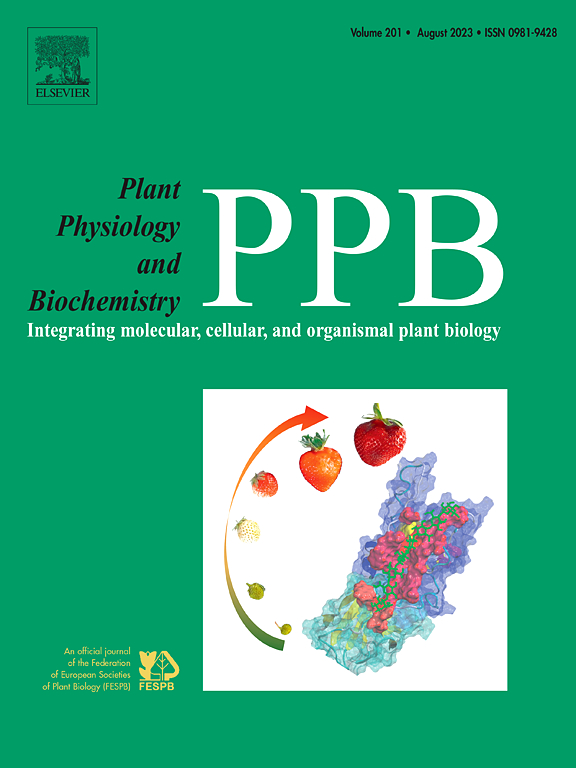卷柏菌14-3-3蛋白同工型的生化特性为其系统发育类群的进化提供了新的思路
IF 5.7
2区 生物学
Q1 PLANT SCIENCES
引用次数: 0
摘要
14-3-3蛋白的许多异构体通过与磷酸化的伴侣蛋白相互作用调节植物生长、营养吸收、开花和信号传导。近年来,人们发现拟南芥中14-3-3亚型的两个主要系统发育类群(epsilon和非epsilon)具有不同的生化特性,但对非模式和早期分化植物谱系中的14-3-3蛋白仍未进行深入研究。本文报道了一种代表古代维管植物的石松类植物Selaginella moellendorffii的14-3-3亚型的比较研究。我们发现,像其他已知的14-3-3一样,所有卷草14-3-3异构体形成同型二聚体并结合磷酸肽。然而,正如最近在拟南芥中发现的那样,epsilon型同种异构体Sm230088显示出单体化的倾向,但程度较小。虽然Sm230088的热力学和蛋白水解稳定性较低,表面疏水性较Sm439395和Sm229825高,但卷藻14-3-3同工型总体上比拟南螺旋体稳定得多,形成更紧密的二聚体,epsilon和非epsilon同工型之间的生化差异不明显。这表明植物14-3-3蛋白可能随着时间的推移而进化的稳定性降低,而对每个系统发育组的这一趋势的反向外推表明,与之前的假设相反,植物14-3-3蛋白可能起源于祖先的非epsilon形式,而不是epsilon形式。本文章由计算机程序翻译,如有差异,请以英文原文为准。

Biochemical characterization of Selaginella 14-3-3 protein isoforms provides insights into the evolution of their phylogenetic groups
Numerous isoforms of 14-3-3 proteins regulate plant growth, nutrient uptake, flowering, and signaling by interacting with phosphorylated partner proteins. Recently, the two major phylogenetic groups of 14-3-3 isoforms in Arabidopsis thaliana, epsilon and non-epsilon, were found to have distinct biochemical properties, but 14-3-3 proteins in non-model and early-diverging plant lineages remain unexplored. Here, we report a comparative study of 14-3-3 isoforms from Selaginella moellendorffii, a lycophyte representing ancient vascular plants. We show that, like other known 14-3-3s, all Selaginella 14-3-3 isoforms form homodimers and bind phosphopeptides. However, the epsilon-type isoform Sm230088 displays a tendency to monomerize, as recently discovered for Arabidopsis epsilon-type isoforms, but to a lesser extent. Although Sm230088 exhibits lower thermodynamic and proteolytic stability and higher surface hydrophobicity than its non-epsilon counterparts, Sm439395 and Sm229825, Selaginella 14-3-3 isoforms are overall much more stable and form tighter dimers than those in A. thaliana, with notably less pronounced biochemical differences between epsilon and non-epsilon isoforms. This suggests that plant 14-3-3 proteins may have evolved reduced stability over time, while back extrapolation of this trend for each phylogenetic group indicates that, contrary to previous assumptions, plant 14-3-3 proteins likely originated from ancestral non-epsilon, rather than epsilon forms.
求助全文
通过发布文献求助,成功后即可免费获取论文全文。
去求助
来源期刊
CiteScore
11.10
自引率
3.10%
发文量
410
审稿时长
33 days
期刊介绍:
Plant Physiology and Biochemistry publishes original theoretical, experimental and technical contributions in the various fields of plant physiology (biochemistry, physiology, structure, genetics, plant-microbe interactions, etc.) at diverse levels of integration (molecular, subcellular, cellular, organ, whole plant, environmental). Opinions expressed in the journal are the sole responsibility of the authors and publication does not imply the editors'' agreement.
Manuscripts describing molecular-genetic and/or gene expression data that are not integrated with biochemical analysis and/or actual measurements of plant physiological processes are not suitable for PPB. Also "Omics" studies (transcriptomics, proteomics, metabolomics, etc.) reporting descriptive analysis without an element of functional validation assays, will not be considered. Similarly, applied agronomic or phytochemical studies that generate no new, fundamental insights in plant physiological and/or biochemical processes are not suitable for publication in PPB.
Plant Physiology and Biochemistry publishes several types of articles: Reviews, Papers and Short Papers. Articles for Reviews are either invited by the editor or proposed by the authors for the editor''s prior agreement. Reviews should not exceed 40 typewritten pages and Short Papers no more than approximately 8 typewritten pages. The fundamental character of Plant Physiology and Biochemistry remains that of a journal for original results.

 求助内容:
求助内容: 应助结果提醒方式:
应助结果提醒方式:


